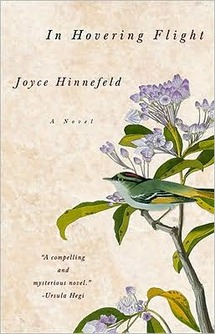Reviewed by Grant McCreary on November 17th, 2009.
This may come as a shock, but I don’t only read bird books. I love reading fiction from authors such as Douglas Preston and Lincoln Child, Vince Flynn, and Tom Clancy (if he’d ever write another one). I also enjoy science fiction/fantasy, like Tolkien, the Star Wars novels, and, recently, The Song of Ice and Fire series by George R.R. Martin. I only mention this to show that I don’t normally read novels like In Hovering Flight. And yet I still really enjoyed it.
The book opens in a beach cottage, where Scarlet Kavanagh has come to be with her mother, Addie, on her deathbed. After she dies, Scarlet, her father, Tom, and two of Addie’s old friends face a dilemma in carrying out Addie’s final wishes. But before we find out what those were, the reader is slowly filled in on the events leading up to this via flashbacks and the character’s reminiscences.
The story really begins back in the mid 1960’s when Addie takes Tom’s ornithology course at a small college. The two quickly fall for each other and eventually marry. Addie’s love of birds and art leads her to illustrate the book Tom writes about bird song. But as Addie becomes aware of the degradation of the environment at the hands of man, she becomes withdrawn from her family and prior passions, and more focused on the nascent environmental movement. Her fervor obviously impacts her relationship with family and friends, but also ends up having a profound impact on how she dies.
After getting to know her parents, we move along to Scarlet (who, unsurprisingly given her parents, was named after the tanager). Tom and Addie’s story was never far removed from the birds they loved, but Scarlet went on to become a poet. I was expecting my interest to wane after this shift, but I was surprised to find it did not. In many ways, Scarlet is the central character of the novel, and becomes more well-rounded and sympathetic than the others, especially her mother.
In retrospect, it seems that not much actually happens until the very end. But it doesn’t feel that way while reading it. The character interactions are absorbing, and you feel like you really get to know the Kavanaghs and their friends. And the almost lyrical prose makes the story fly along quickly.
Birds are prominent in the story, but they’re really in more of a supporting role. The characters and their relationship with each other are the heart of the tale. The author is obviously interested in birds, but I don’t know if she would consider herself a birder. But if not, she definitely did her homework, as she got the little details right. She even has the little known Cuvier’s Kinglet playing a small, but important, part. This is a bird that Audubon painted (that’s it on this book’s cover), but no one has seen since. Was this a rare bird when Audubon came across it and has since become extinct? Or did it ever really exist in the first place? Its use was a nice touch, as there is a similar sense of uncertainty about it in the story. And as the author explains, it is “a fitting emblem of [the] characters’ elusive desires.”
Recommendation
This a worthwhile read if you’re looking for a good novel. Even if you don’t normally read character dramas such as this, give it a shot. I was glad I did.
You can find out more about this book, and even read excerpts, on the book’s website.
Disclosure: I get a small commission for purchases made through links in this post.
Disclosure: The item reviewed here was a complementary review copy provided by the publisher. But the opinion expressed here is my own, it has not been influenced in any way.



Comment